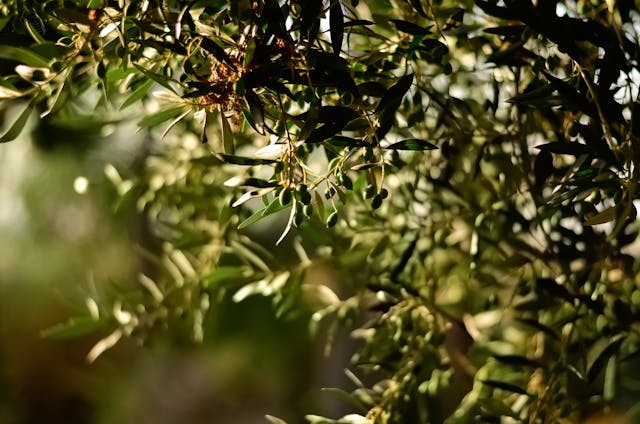Due to its drought tolerance, the olive (Olea europaea), the quintessential Mediterranean tree, is becoming more and more well-liked in the UK. It makes an excellent garden plant in warmer climates when given a protected, south-facing site. Its silvery evergreen leaves glitter in the sun and sparkle at night, and with the correct care, it may even bear fruit every year.

In the famous orchards that round the Mediterranean coast, 90% of the world’s olives are grown. The majority are replaced around the age of 80 since they are farmed, but the survivors may live to astonishingly long ages—some veterans are said to be 2,000 years or more. Their twisted bark, which bends and bobbles like bloated rope or flows like hardened lava, becomes more distinctive the older they become. It seems sense that olive growers think conversing with their trees would result in high-quality fruit or oil.
One of the first domesticated crops known to man, olives may have been cultivated in Asia Minor as early as 6000 BC, while other experts think the Egyptians were the first to graft the wild olive (oleaster). Olive oil was a major business for the ancient Mediterranean civilizations, including the Phoenicians and the Romans. In the second century AD, Rome imported 7.5 million liters of olive oil annually.
The olive tree was revered for its abundant supply of food, fuel, basis for cosmetics and medicines, long life, and ability to generate light via its leaves capturing sunlight and its oil used in lamps. Because oil was so often given as a gift and used to build strong trade relations, it became a heavenly tree in Jewish, Christian, and Muslim iconography. It was also known as the tree of peace.
In the right circumstances, it may be enjoyed year-round in the garden, with silvery evergreen foliage, ivory summer blooms, and, if you’re fortunate, tasty, smoky olives to eat.
Which olive tree should I plant?
The European olive (Olea europaea) comes in more than 700 variants. Some, like ‘Arbequina,’ a Spanish variety that fruits early on, and ‘Picual,’ a short olive with silvery leaf, are more tolerant of the UK climate than others. Both are compact and self-fertile. ‘Hojiblanca’ is a bigger tree with light-catching leaves that have a little shine to them. However, it needs another tree nearby, like ‘Arbequina’, to be pollinated in order to bear fruit.
How to grow an olive tree
In cooler climates, plant in April or May in a sun-baked, protected area in extremely well-drained deep earth. If your soil is thick, consider planting on raised beds or adding a lot of sharp sand to aid drainage. In order for the tree to bear fruit properly, it also needs fertile soil.
In milder climates: Olives can tolerate brief periods of low temperature (as low as -10°C), but it’s best to plant them in pots so they may be protected from the elements throughout the winter. Plant a compact form (like “Arbequina”) in a pot with drainage holes, filling it with a mixture of sharp sand and loam-based John Innes No 3 compost. Set the pot on a plant caddy so that it can be wheeled inside.

How to cultivate an olive tree
Sunbathing: In the UK, warmer climates are ideal for olives since that’s when they’re most likely to bear fruit. They need as much sun as possible, therefore a location that faces south is essential.
Protect your plants from chilly winds by planting them in a location free from frost pockets. If you choose to plant your olive in the ground, cover it with horticultural fleece in late fall. In milder climates, it’s typically preferable to put your olive in a container and transfer it under cover before winter.
Moisture: Older trees benefit from irrigation in hot, dry weather, while olives, despite their remarkable drought tolerance, nevertheless need to be watered until they get established. If your soil is not already well drained, add a lot of sand before planting since they detest sitting in wet soil.
Food: During late spring or summer, your tree needs a reasonable quantity of nitrogen-rich food if you want it to bear fruit. Sheep dung is a common mulch used by olive farmers, while chicken manure is an equally effective source of nitrogen.
Elbow room: Olives need room to breathe, so make sure the area around them is free of other plants or, at the very least, overgrown foliage.
Aeration: In order to aerate the soil and remove weeds, olive farmers scrape the ground around their trees in the spring.
Pruning: An olive may be done in 1,001 different ways. They carefully shape them into short, bushy, squat trees with a single, broad trunk in Tuscany. With a stem that divides into three major branches and enough room for a bird to fly between them, the olive trees in Provence are higher. Furthermore, some Moroccan farmers don’t even prune. The majority of farmers agree that olives grow better and provide more fruit when given a haircut. Cutting encourages development, increases light penetration into the plant, and lessens resistance while harvesting fruit. Eliminate any wood that crosses other branches, produces shade, or has already produced fruit while doing this in the spring or fall. The plant will provide its next harvest when it has healthy, new growth, so avoid cutting it. Also, be careful not to remove the tops of the stems that have not yet produced fruit. Take off the branches that the plant grows from its roots surrounding the base.
Harvesting: Olive trees may provide fruit in the milder regions of the United Kingdom. This fruit may be picked in the fall or in the winter when it becomes black. To make olives edible, they need to be cleaned of their bitterness. There are several ways to tackle this; every Mediterranean community has its own strategy. With a knife, delicately score the autumn’s green olives. Then, soak them in water for one to two weeks, changing the water every one to two days. After that, brine them for two to six months in sterile jars of salty water, adding vinegar, green chili, or lemon to the brine if desired.




